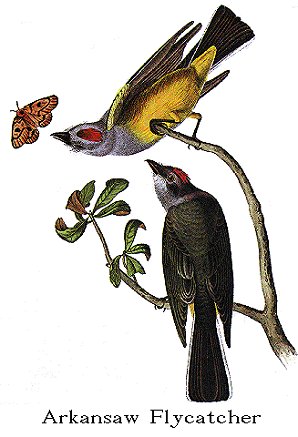
| Family VII. MUSCICAPINAE. FLYCATCHERS. GENUS II. MUSCICAPA, Linn. FLYCATCHER. |
Next >> |

Family |
ARKANSAW FLYCATCHER. [Western Kingbird.] |
| Genus | MUSCICAPA VERTICALIS, Bonap. [Tyrannus verticalis.] |
This species extends its range from the mouth of the Columbia river, across
our continent, to the shores of the Gulf of Mexico; but how far north it may
proceed is as yet unknown. On the 10th of April, 1837, whilst on Cayo Island,
in the Gulf of Mexico, I found a specimen of this bird dead at the door of a
deserted house, which had recently been occupied by some salt-makers. From its
freshness I supposed that it had sought refuse in the house on the preceding
evening, which had been very cold for the season. Birds of several other
species we also found dead on the beaches. The individual thus met with was
emaciated, probably in consequence of a long journey and scanty fare; but I was
not the less pleased with it, as it afforded me the means of taking measurements
of a species not previously described in full. In my possession are some
remarkably fine skins, from Mr. TOWNSEND'S collection, which differ considerably
from the figure given by BONAPARTE, who first described the species. So nearly
allied is it to the Green-crested Flycatcher, M. crinita, that after finding the
dead bird, my son and I, seeing many individuals of that species on the trees
about the house mentioned, shot several of them, supposing them to be the same.
We are indebted to the lamented THOMAS SAY for the introduction of the Arkansaw
Flycatcher into our Fauna. Mr. NUTTALL has supplied me with an account of its
manners.
"We first met with this bold and querulous species, early in July, in the
scanty woods which border the north-west branch of the Platte, within the range
of the Rocky Mountains; and from thence we saw them to the forests of the
Columbia and the Wahlamet, as well as in all parts of Upper California, to
latitude 32 degrees. They are remarkably noisy and quarrelsome with each other,
and in the time of incubation, like the King-bird, suffer nothing of the bird
kind to approach them without exhibiting their predilection for battle and
dispute. About the middle of June, in the dark swamped forests of the Wahlamet,
we every day heard the discordant clicking warble of this bird, somewhat like
tsh'k, tsh'k, tshivait, sounding almost like the creaking of a rusty door-hinge,
somewhat in the manner of the King-bird, with a blending of the notes of the
Blackbird or Common Grakle. Although I saw these birds residing in the woods of
the Columbia, and near the St. Diego in Upper California, I have not been able
to find the nest, which is probably made in low thickets, where it would be
consequently easily overlooked. In the Rocky Mountains they do not probably
breed before midsummer, as they are still together in noisy quarrelsome bands
until the middle of June."
Mr. TOWNSEND'S notice respecting it is as follows: "This is the
Chlowish-pil of the Chinooks. It is numerous along the banks of the Platte,
particularly in the vicinity of trees and bushes. It is found also, though not
so abundantly, across the whole range of the Rocky Mountains; and along the
banks of the Columbia to the ocean, it is a very common species. Its voice is
much more musical than is usual with birds of its genus, and its motions are
remarkably quick and graceful. Its flight is often long sustained, and like the
Common King-bird, with which it associates, it is frequently seen to rest in the
air, maintaining its position for a considerable time. The males are
wonderfully belligerent, fighting almost constantly, and with great fury, and
their loud notes of manner and defiance remind one strongly of the discordant
grating and creaking of a rusty door-hinge. The Indians of the Columbia accuse
them of a propensity to destroy the young and eat the eggs of other birds.
TYRANNUS VERTICALIS, Say, Long's Exped., vol. ii. p. 60.
ARKANSAW FLYCATCHER, Muscicapa verticalis, Bonap. Amer. Orn.,
vol. i. p. 18.
MUSCICAPA VERTICALIS, Bonap. Syn., p. 67.
ARKANSAW FLYCATCHER, Muscicapa verticalis, Nutt. Man.,
vol. i. p. 273.
ARKANSAW FLYCATCHER, Muscicapa verticalis, Aud. Orn. Biog.,
vol. iv. p. 422.
The outer five primaries much attenuated toward the end, the first more so,
the fifth least, the third longest, but the outer four nearly equal; tail almost
even. Upper parts ash-grey, the back tinged with yellow; a patch of bright
vermilion on the top of the head; wing-coverts and quills chocolate-brown; upper
tail-coverts and tail black, the outer web of the lateral feathers
yellowish-white; throat greyish-white, sides and fore part of neck ash-grey, the
rest of the lower parts pure yellow. Female similar.
Male, 9, 15 1/2.
| Next >> |